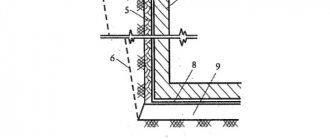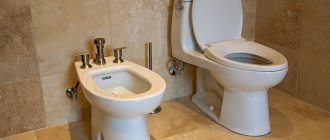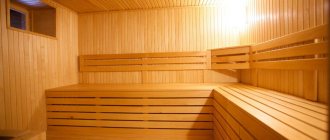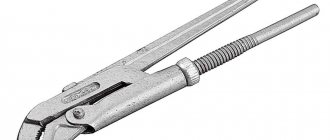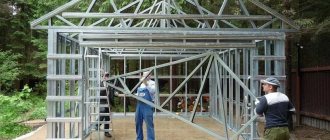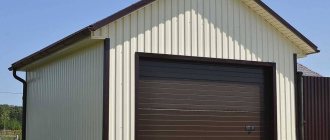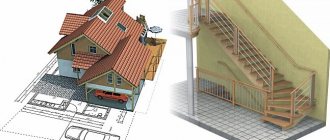Homeowners use their basement or basement in different ways. Some will equip a workshop there, some will equip a bathhouse or sauna, others will equip a boiler room and a warehouse. In recent years, cars have appeared in almost every family, and often there is more than one car in the house. That is why there is an urgent need for parking a car, which in a small area and lack of free space is a real problem. The solution to this problem is to install a garage in the basement of the house. This is a rational option that is popular in Western countries.
Operable ground floor
The dream of any car enthusiast is a convenient garage located near a private home, or even better, directly in the basement or on the ground floor.
An equipped, usable basement floor provides comfortable living in a private house due to the placement of technical and other auxiliary premises in the basement. Therefore, the project of a house with a garage in the basement is especially popular; such a project can be ordered on the website of the construction company Deutek. This project is a rational and practical use of the space limited by the walls of the foundation of the house, located below the floor level.
However, the garage project is complicated because it will require the construction of an inclined ramp and a drainage system from it. Moreover, to install a ramp it is necessary to fulfill certain requirements.
Features of a basement inspection
Before opening any commercial enterprise in the CEZ, it is necessary to conduct a survey of its premises. To do this, they enter into an agreement with an organization that has the right to provide such services.
Such an inspection must be carried out by the owner of the building or the CEZ. But, firstly, it could have been carried out quite a long time ago, and the entrepreneur must make the decision on renting and the associated risks, including the costs of finishing, repairs and re-equipment of the premises “here and now”, and secondly, landlords are trying convince businessmen to pay for examinations.
During the examination, the following is checked:
- Proper arrangement of the premises and the presence of damage, as well as defects in the structures of the Central Economic Zone, including load-bearing ones, and the construction of the foundation. Have soil features been taken into account during construction?
- Compliance of the premises with the requirements for lighting, humidity, sanitary and hygienic conditions, etc. The presence of a waterproofing barrier, flooding or flooding is detected.
- The condition and operability of the water supply and sewerage systems, air purification systems, ventilation and insulation of premises, as well as the presence of defects during construction or repairs.
- Possible violation of the insulation of wires, their “sagging”, as well as upholstery materials and structures (shelves and racks, panels, wooden structures, plywood and other materials).
- The presence and validity of disputes of various types between owners, residents, tenants, and so on in relation to the premises being inspected.
- Determining the purpose of the premises, the possibility of their use for a given business and the presence of walls with a reasonable choice of height.
The inspection ends with the issuance of a corresponding report with the attachment of various documentation depending on its specific results. It is very important for the entrepreneur to familiarize himself with it and follow all the requirements.
Don't forget to inspect the premises
Basic equipment for garage construction
The basic equipment for constructing a garage for one car in the basement or basement is considered to be:
- load-bearing metal frame or FBS frame
- walls equipped with basement siding
- interior finishing of floors, walls and ceilings with insulation and waterproofing
- ramp for entering the garage
- Garage Doors
- canopy
For the construction of a garage, a recessed strip foundation is used, which is placed in accordance with the rules and regulations: “below the freezing level of the soil to a depth of at least 30 cm.” The average depth of a buried foundation is from 1.5 to 2.5 m.
Price issue
Another aspect that must be taken into account when deciding whether to build a basement is financial. In different conditions and under different circumstances, the cost of arranging a basement will differ.
For example, digging a pit on normal soil and a flat area will require less cost than on hard soils and slopes. The cost of a basement will also differ in places with deep groundwater and in places where in the spring, when the snow melts, it rises close to the surface. In the latter case, special attention will need to be paid to enhanced waterproofing. Much will depend on the use of the basement, but in any case, its equipment will require an additional ventilation system and lighting.
In general, the construction of a basement costs 12-17 thousand rubles per 1 m2, and increases the cost of general construction work by 20-35%.
Therefore, with limited financial resources, it is important to think carefully about whether the game is worth the candle, and is there really a need for a basement in the house?!
By the way, you shouldn’t put off building a basement “for later.” Digging a foundation pit for a basement under a finished house is much more difficult, and not every construction organization will undertake such work. A “late” basement can be even more expensive than if it was built at the same time as the house.
The basement can become a very functional space, but only if the work is done well. Otherwise, it can be a real problem for the residents of the house. In addition, in most cases, it is quite possible to do without a basement by properly planning the main building.
How to build a house basement and garage
The following types of base should be distinguished:
- recessed
- bulging
- located flush with the foundation.
You can build a garage with any type of base. A buried foundation is considered the most suitable for building a garage. The technology and construction of the garage are carried out jointly
work on the construction of the basement.
The construction of a house with a garage in the basement begins with the construction of the basement and garage.
Construction stages Let us recall that the construction of the basement and garage is carried out in the following stages:
- terrain planning, marking axes and digging a pit
- sealing the sand bed and pouring the foundation slab
- construction of basement walls
- leveling walls and covering the base with slabs
- laying out the basement with foundation blocks
- pouring slabs with reinforced reinforced screed
- construction of the first floor.
Digging a pit is carried out using special equipment, because the depth of the pit for a house with a basement must be maintained. The basement floor is sealed and waterproofed using a blind area. Along the perimeter of the outer part of the house, to protect the house, a blind area up to 50 cm wide is made of concrete mixture.
Expansion joints and joints between the wall and the blind area, the walls and bottom of the basement and ground floor, as well as the joints of foundation blocks are subject to mandatory waterproofing. To build the foundation and walls of the basement and garage, I use large-sized foundation blocks, strip foundation slabs and FBS (wall foundation blocks), which are placed around the perimeter of the house.
FBS blocks have significant weight, so the construction of the foundation and walls is carried out using special equipment. After the foundation and walls of the basement and basement are erected, the floor slabs are filled with reinforced screed.
This video will help you properly fill your garage floor.
The next stage in the construction of a garage in the basement is the installation of a garage ramp.
What kind of business can you use a basement for?
Since people live above the CEZ, the main thing is to choose a type of business that will not only not arouse negative emotions of the residents of the multi-apartment high-rise building (noise, albeit within acceptable standards and only at the time established by law; attracting antisocial elements of society - homeless people) to the house , drunks, petty thieves, and so on), but on the contrary, will be approved by them (pharmacy, store, hairdresser, repair of small household appliances, etc.), which are applicable to make their lives easier.
Important! A premises of up to 250 sq. m. can be rented. m with possible restrictions on sublease or additional encumbrance - carrying out repairs or some charitable act at the expense of the entrepreneur.
It could be:
- arrangement of a plot of courtyard territory, including a children's playground;
- repairing or painting part of the building's basement;
- repairing and painting the entrance to a nearby house entrance, and so on.
The most common options for using CEZ premises for commercial purposes:
- Shops of various types (except for the sale of flammable items, and also the sale of auto parts is inappropriate, as it will cause an additional influx of cars to the house), culinary, tailoring and clothing repair shops, as well as service centers for the repair of various equipment, including home appliances).
- Pharmacies, order collection points (with production outside the residential building), dry cleaners, laundries and the like.
- Travel agencies, photo studios.
- Hairdressers, massage parlors and/or SPA salons.
- Small bars, restaurants, cafes, bistros.
The plinth can be used for various purposes
Inclined ramp device
Requirements for installing a ramp into a basement garage
A prerequisite for installing an inclined ramp is to maintain the following dimensions:
- the ramp must have a straight, wide plane that exceeds the width of the garage door by 50 cm on both sides
- The recommended length of the ramp is at least 5 m.
- The angle of descent (entry) cannot exceed 25 degrees
- the road surface layer of the ramp must be non-slippery
- the exit must be equipped with a canopy
- A drainage groove is installed between the ramp and the counter-ramp, which is protected with a metal grate.
Such requirements are considered the minimum set for installing a garage ramp in the basement of a house.
how to make your own garage door
We determine the position of the exit plane and mark the site. We dig a small depression over the entire surface of the site to form a sand cushion. Then we level the sand and compact it. The layer of sand cushion can reach 10 cm. Now we arrange the foundation for brick or other supporting walls.
Under the garage wall, the cross-section of the beam is half a brick, namely 200 x 200 mm, and on the sides of the ramp there is a curb made of slabs. Thus, no formwork will be required for the ramp. After compaction, we lay geotextiles and knit a reinforcement cage, which should come close to the garage wall.
The reinforcing mesh is placed at a height of about 75 percent of the total thickness of the screed. Beacons for organizing an inclined ramp are installed at the required angle. The final stage will be concreting the garage ramp. After concreting, slabs or clinker bricks are laid on the garage ramp.
However, after general construction work and the installation of a garage ramp, it is necessary to carry out internal insulation of the walls and ceiling, as well as the floor of the basement and garage.
We insulate the walls, ceiling and floor
Insulation of the basement and garage is carried out outside and inside the structure.
The most affordable materials for insulating basement walls and ceilings are:
- drywall
- plywood sheets
- lining and siding.
The technology for insulating walls and ceilings is as follows. Sheets of insulation are attached to the ceiling and walls using special glue. After fixing the insulation on the entire plane of the wall or ceiling, a vapor barrier layer in the form of foil polyethylene is installed. The vapor barrier layer is attached to the surface of the insulation using construction tape.
Then, to install the finishing cladding, a sheathing of wooden blocks is prepared in the traditional way, which are attached through the insulation to the ceiling or walls using dowels. The finishing cladding is attached to wooden blocks using self-tapping screws. For interior finishing, you can use light-colored C8 wall corrugated sheeting with a profile height of 8 mm.
Additional landscaping activities
The installation of garage doors and canopies can be considered mandatory. The canopy is installed in front of the gate for subsequent use as an additional machine space. For the supporting frame of the canopy, columns are selected that participate in the distribution of the load. The finishing of the frame is carried out in a common style with the facade of the house.
The presence of automated swing, sliding or sectional gates will raise the quality of comfort to the European level. Why not?

